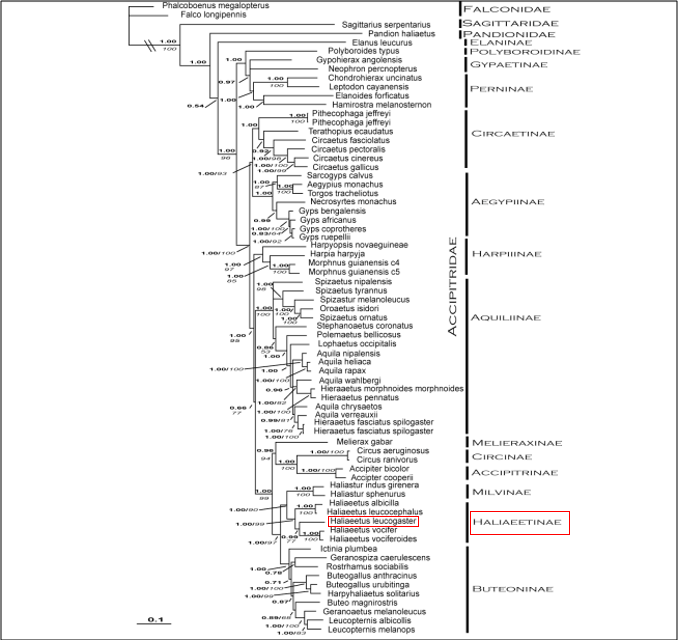Pilumnus vespertilio (Fabricius, 1793)
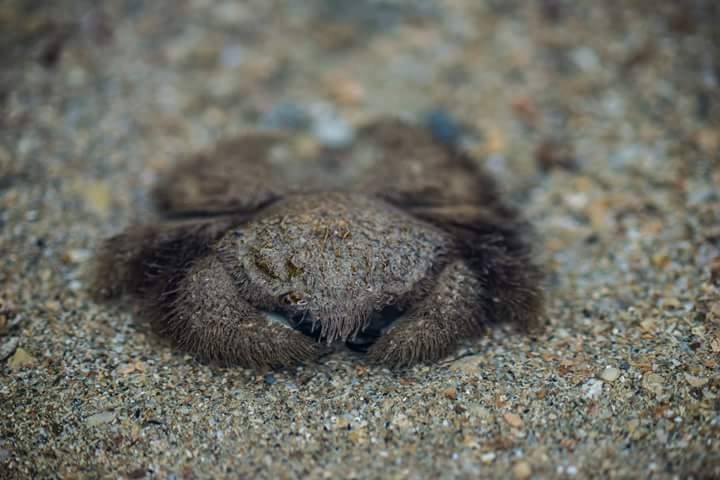 |
| Pilumnus vespertilio. Photo by Stanley Quek, 21 Mar 2015 – Sister’s Island (©). |
Introduction
Crabs of the genus Pilumnus are fairly common residents of Singaporean rocky intertidal habitats. Of the members of this genus, P. vespertilio, the hairy crab, is one of the most common ones. Not to be confused with the edible Chinese mitten crab Eriocheir sinensis (often colloquially called the “hairy crab” as well), this species is often found amongst rocks and coral rubble, especially along the southern shores of Singapore. This mop-like crab has many fine hairs that cover its entire body, allowing it to trap sediment and silt that helps the crab to camouflage itself amongst the rocks and rubble of rocky intertidal shores.
Name
Binomial (scientific) name: Pilumnus vespertilio (Fabricius, 1793) (1)
Original name as first described: Cancer vespertilio Fabricius, 1793 (2)
Etymology: vespertilio – “Bat (animal”) in latin. Named because of its furry appearance, which is similar to that of a bat (3).
Vernacular (common) name(s): (Common) Hairy Crab, Teddy Bear Crab Bad Hair Day Crab (3)(4). However, since the most common name of “Hairy Crab” may be used colloquially to refer to another species (E. sinensis), it is preferable to refer to this species by its scientific binomial name (P. vespertilio), which is unambiguous
Synonyms (1):
- Pilumnus mus Dana, 1825
- Pilumnus ursulus Adams & White, 1849
- Actaea dentata Edmondson, 1935
Distribution
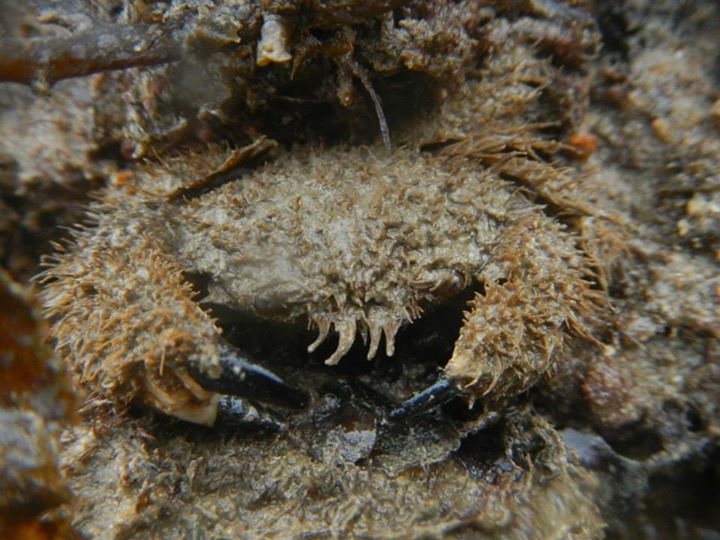 |
| P. vespertilio at St. John’s Island, 2014. Photo by Jonathan Tan ©. |
This species is widely distributed across tropical, subtropical, and temperate waters globally across the Old World and Oceania. Some of the places that they have been found have been listed below (note that this is not an exhaustive list). A more comprehensive list has been compiled here by Sakai (1976) (5).
- Mediterranean Areas
- The Red Sea (6)
- Africa
- Indian Subcontinent/Waters
- Southeast Asia
- East Asia
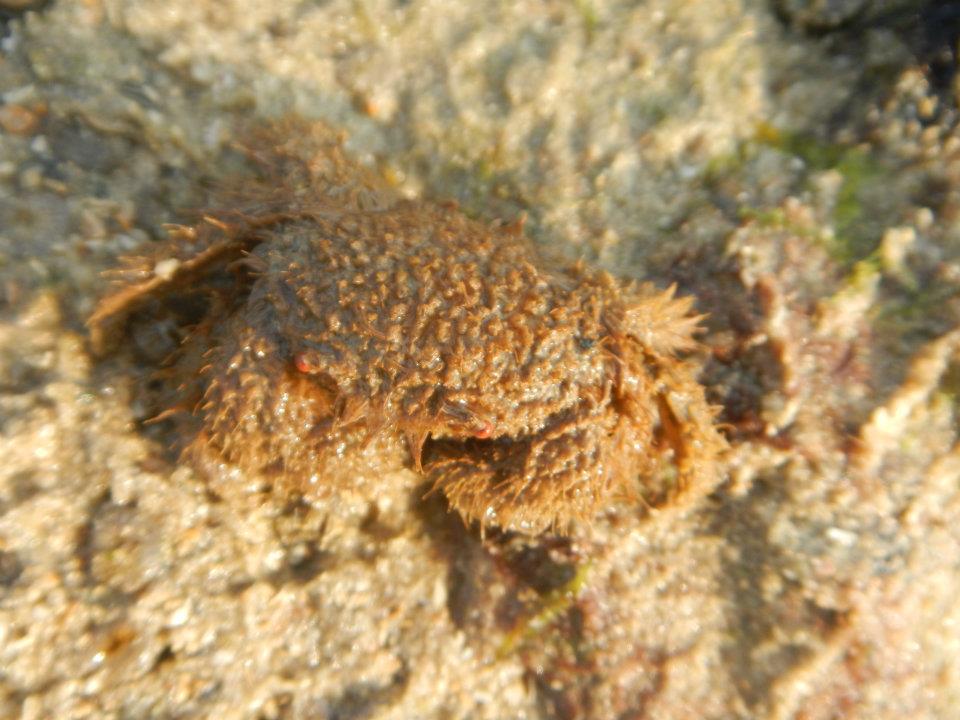
P. vespertilio at Cyrene Reef, 2012. Photo by Jonathan Tan ©. - Australia and Oceania
This widespread distribution may be the result of unintentional (human) introductions, but there is currently no literature on the possible original distribution(s) of P. vespertilio.
In Singapore, P. vespertilio can often be found along southern shores where rocks and coral rubble are present. Such locations include Tanjung Rimau on Sentosa Island, Cyrene Reef, Labrador Park beach, and the Southern Islands. This species has also been found on Chek Jawa on Pulau Ubin, as well as the shores on Pulau Tekong (2)(19).
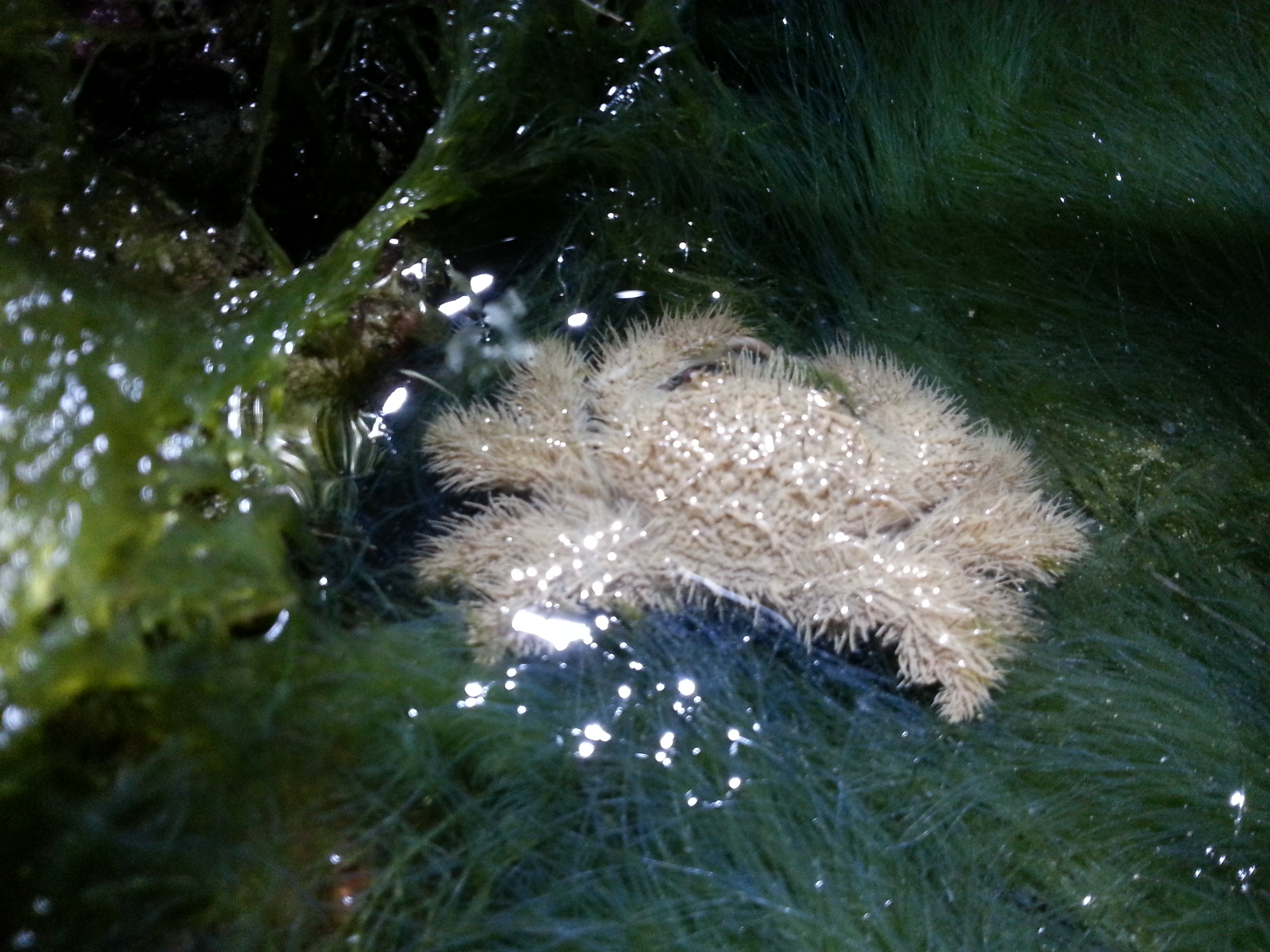 |
| P. vespertilio at Tanjung Rimau, Sentosa, 2014. Photo by Chiu Jing Hua ©. |
 |
| Map of known sightings of P. vespertilio in Singapore. Adapted from WildSingapore’s Flickr map for Pilumnus (19). |
Biology
Life Cycle
Pilumnus vespertilio follows a typical life cycle of a marine crab. The adult female crab lays yolky eggs which are carried underneath the crab at the abdomen. Once fertilised by the males, the eggs develop and hatch into larvae, which are released as zooplankton into the water. The larval stages of P. vespertilio include 3 zoeal stages and 1 megalopal stage, after which they moult into small crabs and settle out of the water column onto the substrate of the intertidal habitat (11). Further moults then allow the crabs to reach their full adult size (approx. 3-4cm in carapace width).
<
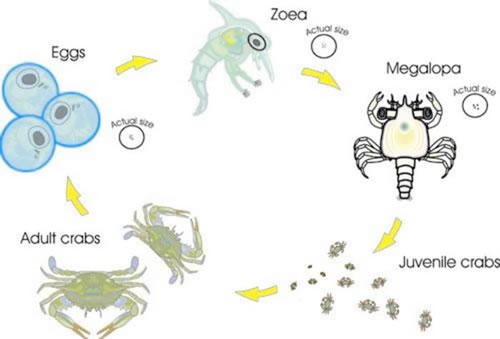 |
| Life cycle of a typical marine brachyuran decapod crab (20). All copyrights reserved by the Smithsonian Institute. |
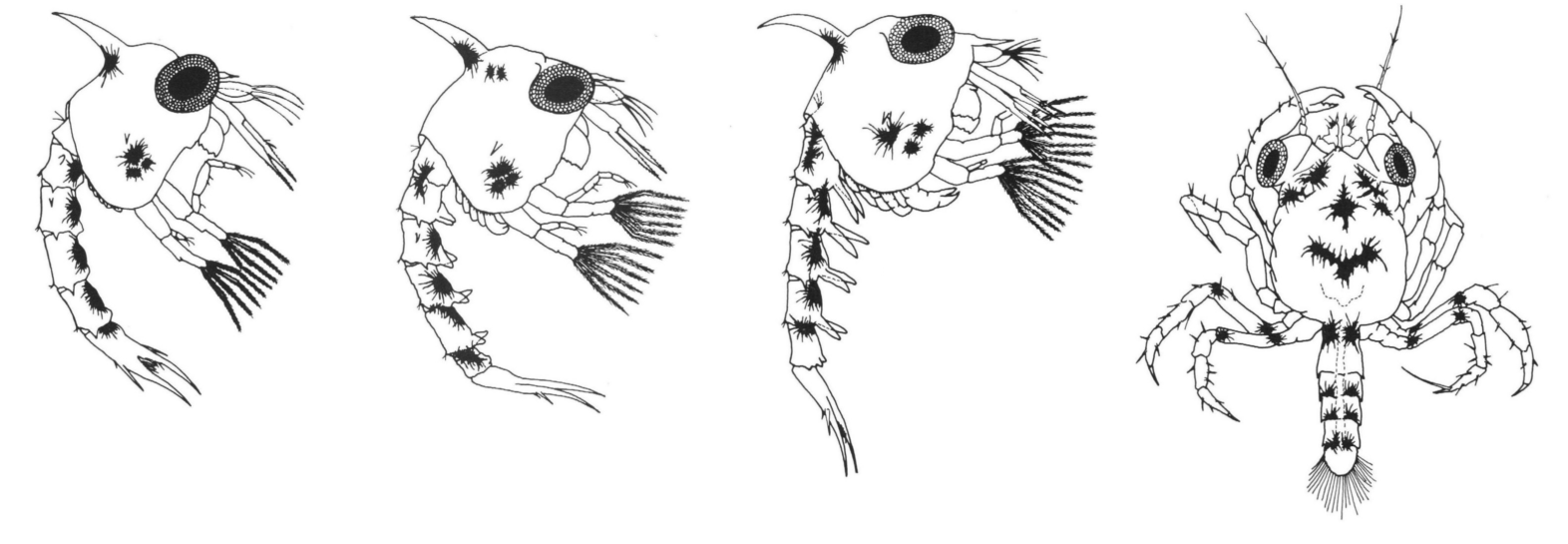 |
| From left to right: Zoea I, zoea II, zoea III, and megalopa stages of P. vespertilio larval development. Adapted from Lim & Tan (1981) (11). |
Pilumnus vespertilio is known to spawn year-round, but generally times its egg release and hatching times with the phases of the moon (15). During the new and full moons, the spring high tides are much higher than normal, with the receding spring low tide able to quickly transport larvae that have been released out into the open sea. As such, they copulate most frequently after the full moon, leading to most females being ovigerous (or egg-bearing) by the next new moon. The females then release their newly-hatched larvae 1-3 days before the full moon during a high tide, ensuring that the high spring tides then wash the larvae out into the open sea to spread and develop. In addition, studies have shown that P. vespertilio spawns more eggs during periods of higher water temperature and higher rainfall, although water temperature does not vary much around Singaporean waters year-round (7).
Diet
Crabs are generally opportunistic omnivores (21) and can use many methods of feeding, including filter feeding, plant/carrion feeding, scavenging and predation (22) and P. vespertilio is not an exception. In general, P. vespertilio consumes a wide range of foods, including crustose coralline algae and various other kinds of red/green/brown algae (2)(22). It is also known to prey on several intertidal animals, including brittle stars, marine gastropods (sea snails), bivalves (clams), bristle worms, and sea slugs (2)(22). In addition, they may also consume toxic zoanthids, which may make some members of this species mildly poisonous (4).
Below are some pictures and a video of P. vespertilio eating various different kinds of food.
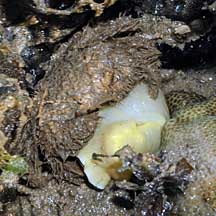 |
| P. vespertilio eating nudibranch. Photo and copyright by WildSingapore (Tan, 2012) (4) |
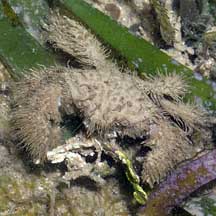 |
| P. vespertilio eating hard seaweed. Photo and copyright by WildSingapore (Tan, 2012) (4) |
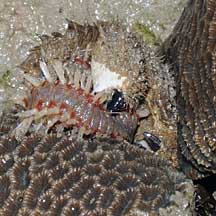 |
| P. vespertilio eating bristleworm. Photo and copyright by WildSingapore (Tan, 2012) (4) |
Ecology
Habitat
Pilumnus vespertilio generally lives along rocky shores and within coral rubble. They are covered with “furry hair” (actually setae), which helps to break up their outline in the water and helps them to camouflage amongst the silt and rocks of their chosen habitat. They are generally shy creatures, and will scuttle into the nearest hole or crevice should it detect any sign of danger around it. Pilumnus vespertilio is more active at night – during the daytime, they tend to hide in holes in the rocks, only coming out at nightime to feed. This, combined with their furry camouflage, makes them a difficult species to spot at times (2).
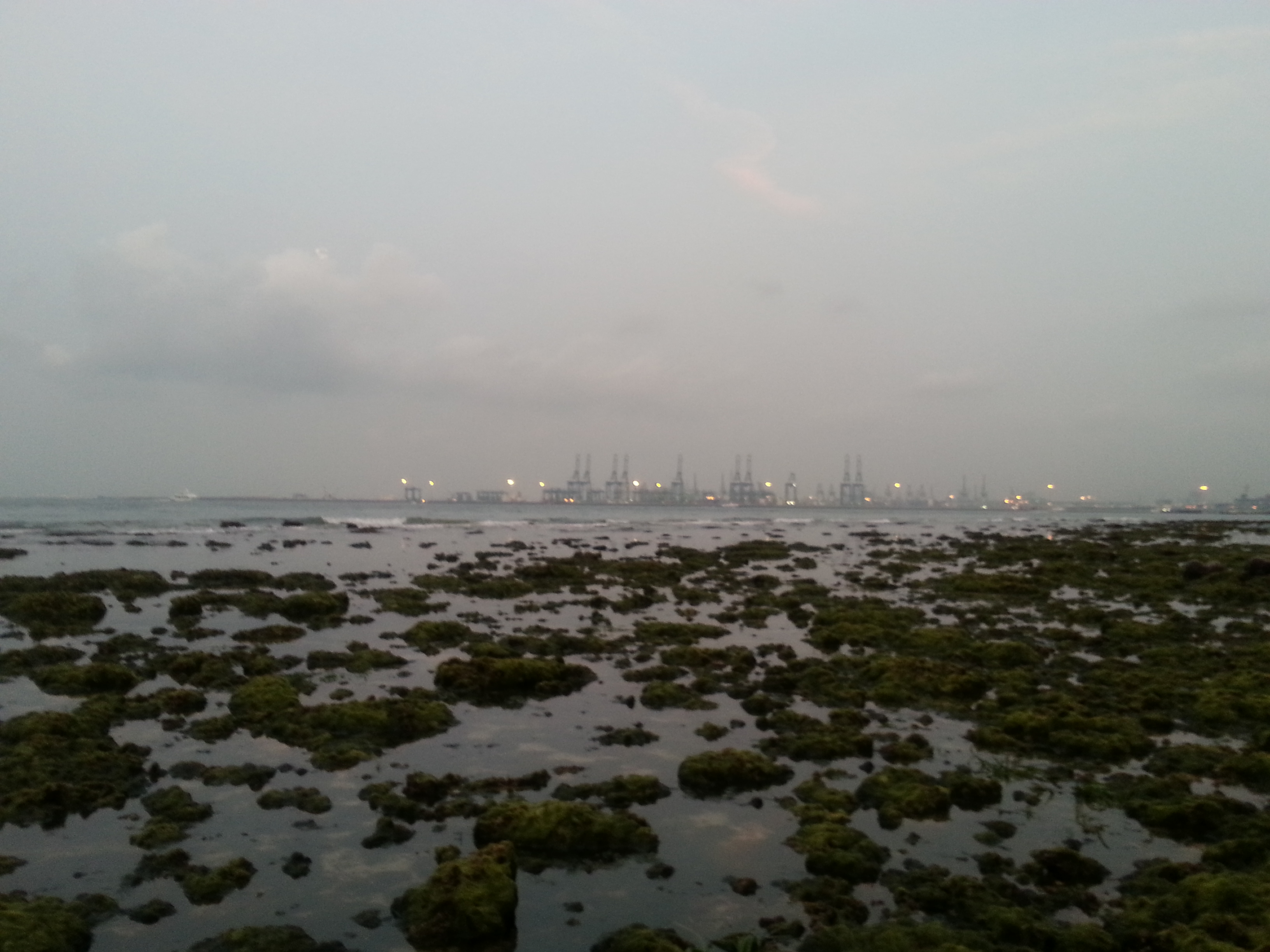 |
| Rocky shores at Tanjung Rimau, Sentosa Island, Singapore (2014). Rocky shores like this are the most common habitats that P. vespertilio inhabit. Photo by Chiu Jing Hua ©. |
Ecological Services
As stated above, they are omnivores and both graze on algae and prey opportunistically on various small invertebrates. As such, they are actively involved in nutrient cycling – studies have shown that recycled nutrients are important to the health of algae in intertidal habitats (23). They also help to speed up decomposition when they tear dead plant and animal matter into smaller pieces.
Conservation
Pilumnus vespertilio has not yet been assessed by the IUCN Red List or CITES, and its relatively widespread distribution makes it likely that it is not an endangered species worldwide. However, that being said, the survival of this species on our highly-disturbed shores is still uncertain, as they are still vulnerable to habitat damage (primarily due to land reclamation and concretisation of seawalls), pollution, and being stepped on by ecotourists due to the increasing interest in visits to the intertidal shores of Singapore (2).
Description
The following description comes from the Marine Species Identification Portal (5)(16).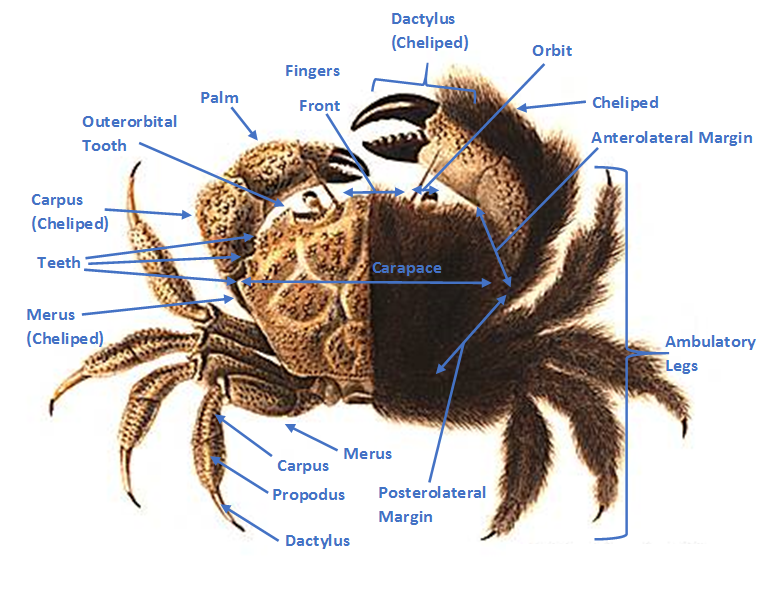 |
| Parts of P. vespertilio, dorsal view. Left half illustrated with setae removed for clarity. Adapted from Milne-Edwards (1842) (5). |
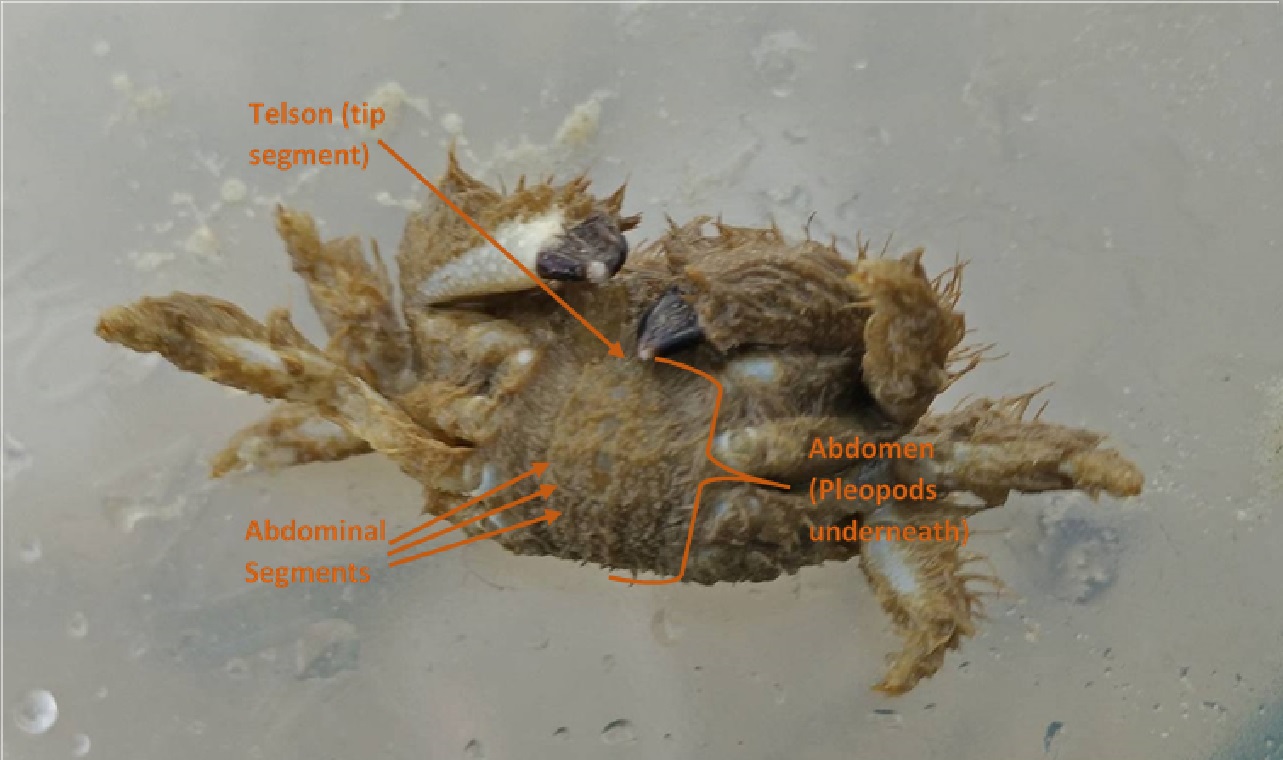 |
| P. vespertilio, ventral view. Photo by Chiu Jing Hua ©. |
| Body Part |
Characteristics and morphology |
| Carapace |
|
| Surface |
|
| Front |
|
| Orbit |
|
| Anterolateral Margin |
|
| Posterolateral margin |
|
| Chelipeds |
|
| Ambulatory Legs |
|
| Abdomen |
|
Type Information and Taxonomy
This species was originally described by the famous Danish zoologist Johan Christian Fabricius in 1793 as Cancer vespertilio (2). The type specimen, originally collected from India, is currently stored in the Fabricius collection in the Zoological Museum of the Natural History Museum of Denmark (under the registration number ZMUC CRU-4595) (24). Fabricius’s original description has not yet been digitised online, although records of the original description can be found (5). He published a later description in 1798 which can be viewed here(25).
The species was then transferred to the genus Pilumnus by French zoologist Henri Milne-Edwards in 1834 (26), on the basis of morphological similarities with other crabs of the genus Pilumnus. Over the years, several people have redescribed this species under different names, but these were all eventually classified as junior synonyms of Pilumnus vespertilio, and the name has so far remained as such until the present day.
Current Taxonomic Classification
(1):- Animalia
- Arthropoda
- Crustacea
- Malacostraca
- Decapoda
- Brachyura
- Pilumnoidea
- Pilumnidae
- Pilumnus
- Pilumnus vespertilio (Fabricius, 1793)
- Pilumnus
- Pilumnidae
- Pilumnoidea
- Brachyura
- Decapoda
- Malacostraca
- Crustacea
- Arthropoda
Phylogeny
Currently, no phylogenetic studies based on genetics have been done for P. vespertilio yet. However, in decapod crustacean phylogenetics, the morphology of first-stage zoea can be used as a tool to determine phylogeny and relationships (27). Since all marine decapod zoea are adapted to a planktonic existence, the morphology of first-stage zoea of marine crabs are not as affected by varying evolutionary pressures that may lead to selection of (possibly convergent) evolutionary traits as that of the adult crabs (which are more directly affected by the evolutionary pressures of their chosen habitat) (27). Even so, there have been few studies on the phylogeny of P. vespertilio in terms of morphology as well. The tree below represents one of the few phylogenetic analyses conducted on this species in scientific literature, and was calculated from 18 morphological characters of first-stage zoea from several taxa in the Pilumnidae family (27) to see how different taxa were related within Pilumnidae. This tree, however, only represents a limited phylogenetic analysis on Pilumnid crab species in general. The data was analysed using a maximum parsimony analysis (Branch and Bound algorithm) and a 50% majority rule consensus was generated from 2 trees with consistency index = 0.5714 and a tree length of 35. The numbers on the branches represent % support for that branch based on this limited analysis from the 2 trees generated.
More information and links
The DNA of Singapore (LKCNHM)
Marine Species Identification Portal
WildSingapore
World Register of Marine Species
References
[1] Davie, P., 2015. Pilumnus vespertilio (Fabricius, 1793). http://www.marinespecies.org/aphia.php?p=taxdetails&id=210158 (accessed 10 Nov. 2015).
[2] Fabricius, J. C., 1793. Entomologia Systematica Emendata et Acuta. Secundum Classes, Ordines, Genera, Species, Adjectis Synonymis, Locis, Observationibus, Descriptionibus. Impensis Christ. Gottl. Proft., Hafniae, 2: 463.
[3] Lee Kong Chian Natural History Museum, 2015. Pilumnus vespertilio (Fabricius, 1793). http://lkcnhm.nus.edu.sg/dna/organisms/details/69 (accessed 10 Nov. 2015).
[4] Tan, R., 2012. Hairy crabs (Pilumnus sp.) on the Shores of Singapore. http://www.wildsingapore.com/wildfacts/crustacea/crab/pilumnidae/pilumnus.htm (accessed 10 Nov. 2015).
[5] Sakai, K., 1976. Pilumnus vespertilio. http://species-identification.org/species.php?species_group=crabs_of_japan&id=1392 (accessed 10 Nov. 2015).
[6] Kossmann, R., 1877. Zoologische Ergebnisse Einer Reise in Die Küstengebiete Des Rothen Meeres. Malacostraca. 1. Theil: Brachyura. W. Engelmann, Leipzig, 1-66 pp.
[7] Litulo, C., 2005. External factors determining the reproductive periodicity in a tropical population of the hairy crab Pilumnus vespertilio (Decapoda: Brachyura: Pilumnidae). Raffles Bulletin of Zoology, 53(1): 115–118.
[8] Lenz, H. & F. Richters, 1881. Beitrag zur Crustaceenfauna von Madagascar. Abhandlungen der Senckenbergischen naturforschenden Gesellschaft, 12: 421–428.
[9] Borradaile, L. A., 1902. Marine Crustaceans. III. The Xanthidae and some other crabs. In: J. S. Gardiner (ed.), The Fauna and Geography of the Maldive and Laccadive Archipelagoes, being the Account of the Work carried on and the Collections made by an Expedition during the years 1899-1900. Transactions of the Linnean Society of London, (Zoology), 1(3): 237–271. Cambridge University Press, Cambridge.
[10] Tan, C. G. S. & P. K. L. Ng, 1994. An annotated checklist of mangrove brachyuran crabs from Malaysia and Singapore. Hydrobiologia, 285(1-3): 75–84.
[11] Lim, S. S. L. & L. W. H. Tan, 1981. Larval Development of the Hairy Crab, Pilumnus vespertilio (Fabricius) (Brachyura, Xanthidae) in the Laboratory and Comparisons With Larvae of Pilumnus dasypodus Kingsley and Pilumnus sayi Rathbun. Crustaceana, 41(1): 71–88.
[12] Rathbun, M. J., 1910. The Brachyura. In: The Danish Expedition to Siam, 1899-1900. V. Kongelige Danske Videnskabernes Selskabs Skrifter, Kjøbenhavn, 5(4): 301–367.
[13] Miers, E. J., 1880. On a collection of Crustacea from the Malaysian region. Part I. Crustacea Oxyrhyncha and Cyclometopa, except Thelphusidae. The Annals and Magazine of Natural History, 5(5): 226–239.
[14]Stimpson, W., 1907. Report on the Crustacea (Brachyura and Anomura) collected by the North Pacific Exploring Expedition, 1853-1856. Smithsonian Miscellaneous Collections, Washington.
[15] Kyomo, J., 2002. Timing and synchronization of the breeding period in Pilumnus vespertilio (Crustacea: Pilumnidae) in subtropical Okinawa, Japan. Pacific Science, 56(3): 317–328.
[16] Dai, A. & S. Yang, 1991. Crabs of the China Seas, English ed. China Ocean Press, Beijing, 364 pp.
[17] Miers, E. J., 1884. Crustacea (Brachyura). Report on the Zoological Collections made in the Indo-Pacific Ocean during the Voyage of H.M.S. Alert 1881-1882. Part I. The collections from Melanesia. Part II. The collections from the Western Indian Ocean. British Museum (Natural History), London, 8: 178–322.
[18] Rathbun, M. J., 1906. The Brachyura and Macrura of the Hawaiian Islands. Bulletin of the United States Fish Commission, 23(3): 827–930.
[19] Tan, R., WildSingapore’s Photos on the Map (Pilumnus). https://www.flickr.com/photos/wildsingapore/tags/Pilumnus/map?&fLat=1.2622&fLon=103.8661&zl=11&order_by=recent (accessed 10 Nov. 2015).
[20] Smithsonian Environmental Research Center, Blue Crab Life Cycle. http://www.serc.si.edu/education/resources/bluecrab/lifecycle.aspx (accessed 10 Nov. 2015).
[21] Kyomo, J., 1992. Variations in the feeding habits of males and females of the crab Sesarma intermedia. Marine Ecology Progress Series, 83: 151–155.
[22] Kyomo, J., 1999. Feeding patterns, habits and food storage in Pilumnus vespertilio (Brachyura: Xanthidae). Bulletin of Marine Science, 65(2): 381–389.
[23] Pfister, C. A., 2007. Intertidal invertebrates locally enhance primary production. Ecology, 88(7): 1647–1653.
[24] ZMUC Invertebrate Department, 2006. Types in the Crustacea collection. http://www.zmuc.dk/InverWeb/invertebrater/Crustacea%20databases/Crustacea%20species%20s-z.htm (accessed 9 Nov. 2015).
[25] Fabricius, J. C., 1798. Supplementatum Entomologiae systematicae. Proft & Storch, Hafniae, 382 pp. http://www.biodiversitylibrary.org/item/132638#page/346/mode/1up (accessed 9 Nov. 2015).
[26] Milne-Edwards, H., 1834. Histoire Naturelle des Crustacés, comprenant l'anatomie, la physiologie et la classification de ces animaux. Libraire Encyclopédique de Roret, Paris, 1: 415-418.
[27] Clark, P. F., 2009. The Bearing of Larval Morphology on Brachyuran Phylogeny. In: J. W. Martin, K. A. Crandall & D. L. Felder (eds.), Decapod Crustacean Phylogenetics. CRC Press, Boca Raton, Florida. Pp. 221–244.
